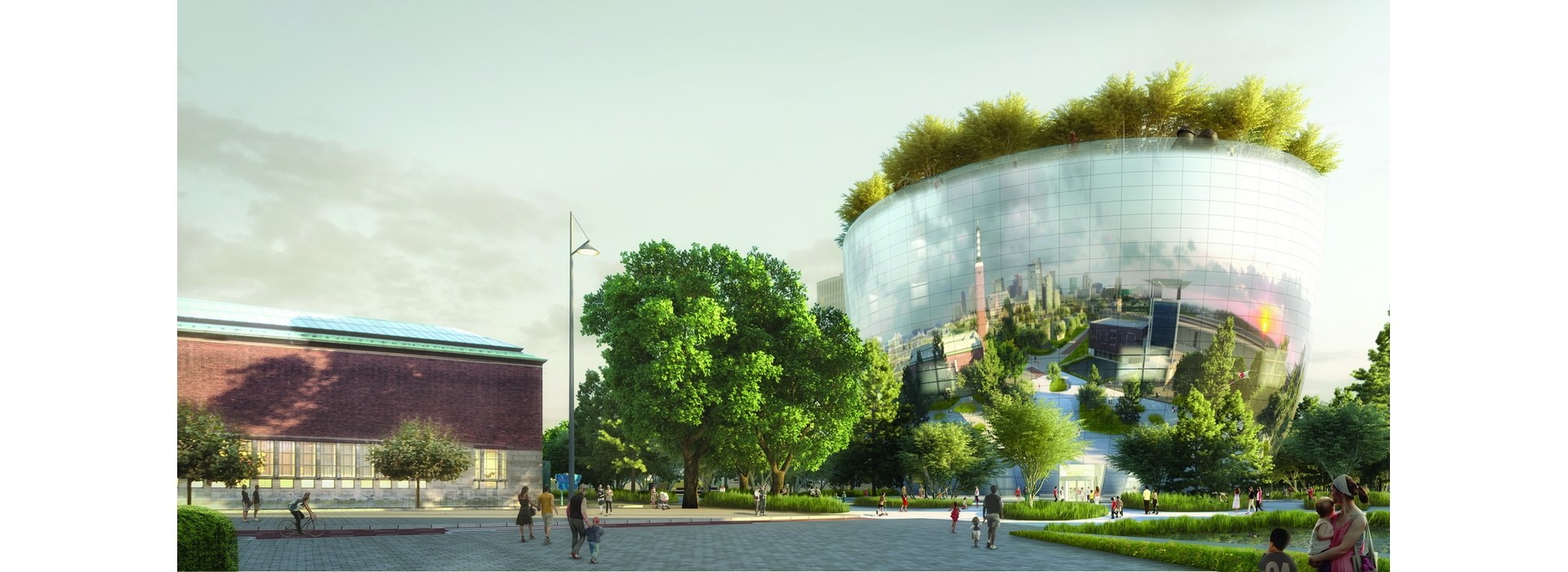

A Giant’s Mirror
The outside of the depot is nearing completion. As if the bowl shape were not extraordinary enough, the mirrored façade is even more striking. The mirrors are more than a spectacular eye-catcher, springing as they do from a long cultural, architectural and art historical tradition. Novelist Peter Delpeut, architect Winy Maas and museum director Sjarel Ex discuss the significance of the depot’s mirror wall from different perspectives. Is it a giant’s mirror, the Rotterdam Panorama or a cherished feature? Or perhaps all three?
Architects MVRDV presented their design for Depot Boijmans Van Beuningen using an astonishing artist’s impression. A mirrored façade with all the characteristics the great landscape painters use to impress us. In the foreground are the fine details of a bright green canopy of leaves. On either side are classical structures that act like the wings of a stage set to draw our gaze along winding paths to a ridge. And, to add to that, a sky laden with storm clouds and early evening light. Unmistakably Rotterdam’s skyline, but only as a painter can transform it. Architect Winy Maas promised us not just a building, but a landscape.
In the meantime, we can see the spectacular twentyfirst-century views for ourselves. Yet not many people will realize that this mirrored spectacle places them in a forgotten tradition. When I saw the artist’s impression for the first time, I immediately thought of the Claude glass, or black mirror. It’s a small eighteenth-century gadget that cleverly brought together a mirror, a painting and a landscape. The Claude glass was slightly convex ground glass blackened mirror, no larger than a powder compact. Walkers would take them along on their expeditions. When they reached their favourite viewpoints, they would do something strange. Turning their backs on the landscape, they would admire the surroundings using the mirror. What they saw looked like a painting, or more particularly a landscape by the seventeenth-century French painter Claude Lorrain (1600-1682).

We don’t know who invented this little mirror. It certainly wasn’t Claude, whose works enjoyed unprecedented popularity in Great Britain in the eighteenth century. Curiously, walkers tried to track down Claude landscapes on that rainy island, for Claude primarily painted the sun-drenched countryside around Rome. Idealized depictions, none of them reflected reality. They were artist’s impressions of the Roman Campagna, where shepherds, sheep and ruins are bathed in divine sunlight. This little mirror’s properties helped walkers to conjure up that illusion in England, Wales and Scotland too.
Visitors to the depot will also have just such a mirror. Following in the footsteps of eighteenth-century walkers, the actual landscape does not stretch out in front of our
eyes but behind our backs. We look in a giant’s Claude glass. Rotterdam transformed into one huge painting by Claude. And if we don’t want to wait for the famous evening light, we go indoors where we can see the divine sunset in ‘Landscape with Figures Wading Through a Stream’ (1637) – a real Claude that needs no mirror and is always available.
Peter Delpeut recently published the novel ‘In het zwart van de spiegel’ in which the Claude glass plays a prominent role.

Cherished feature
Depot Boijmans Van Beuningen will be a cherished feature of Rotterdam’s landscape, and the reflective façade will help. It makes the building transparent so that it becomes part of its surroundings – Museumpark. Yet the depot has to have a certain presence because we’re working on a building that people will soon be coming especially to see, a new selfie hotspot. This façade, with its doubly curved mirrors, is unique. We had to do a lot of testing – how can you control the incidence of light, interior climate and degree of transparency? The greatest challenge was to get the mirrors beautifully joined together, with the narrowest possible joints. In the end we succeeded. The reflective façade is part super high-tech and at the same time the epitome of craftsmanship.

Rotterdam Panorama
People like to gaze – at art, at movies and at natural beauty. This has always been the case. Be a spectator at the Battle of Waterloo? The Panorama was a travelling phenomenon, on show at fairs and on saints’ days, until well into the nineteenth century. It was almost real, as if you were there yourself. The Mesdag Panorama, giving a 360-degree vista around Scheveningen, was another such phenomenon. Our Rotterdam Panorama is a descendant. Reversed and present day, dynamic, the depot’s reflection combines clouds with cityscapes. A mirage that pales reality. A selfie of three hundred people – à la Magritte? Hallucinations and illusions, reduced to a one-tenth scale, a huge silvered bowl for Rotterdam’s big beautiful art collection. There’s never been anything like it.
Depot Journal
This article has been published before in Depot Journal #3 which is part of a series of six. If you would like to receive all the printed Depot journals by post, please send an email to info@boijmans.nl with your full name and address, reference ‘receive Depot Journals’.

